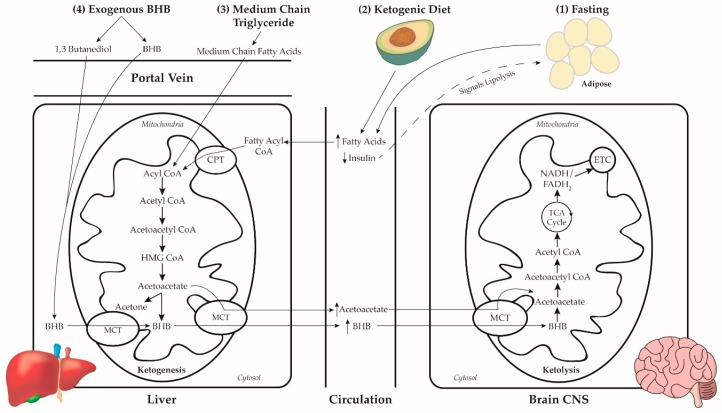Figure 1.
The major mechanisms to induce ketosis. (1) After glycogen stores are exhausted during prolonged fasting, lower levels of circulating insulin signals lipolysis of endogenous adipose, resulting in a rise in circulating free fatty acids, and ketogenesis. Fatty acids are transported into liver mitochondria for synthesis of the ketone bodies acetoacetate, β-hydroxybutyrate, and acetone to a lesser degree. Ketone bodies are transported out of the mitochondria via monocarboxylate transporters (MCT) 1 and 2, enter circulation, and enter extra-hepatic mitochondria via the same MCT 1 and 2 for ketolysis. Ketone bodies are retroconverted to acetyl CoA, enter the citric acid (TCA) cycle for ATP production, and the resulting NADH and FADH2 facilitate energy production via the electron transport chain (ETC). (2) The KD’s exogenous fat substrate and restricted carbohydrate initiates an action similar to fasting by increasing circulating fatty acids and reduced insulin. During a KD, both exogenous and endogenous fatty acids are destined for ketogenesis. (3) Medium chain triglycerides are gastrointestinally digested to medium chain fatty acids, absorb across the intestinal lumen, and rapidly enter the liver via the portal vein, bypassing the lymphatic system and peripheral circulation. Medium chain fatty acids enter the ketogenesis pathway at the level of acetyl CoA. (4) Exogenous β-hydroxybutyrate esters are cleaved into β-hydroxybutyrate and 1,3 butanediol by local gut esterases. Both products enter the liver via the portal vein, enter mitochondria at the β-hydroxybutyrate or acetoacetate level of ketogenesis, and enter circulation as β-hydroxybutyrate or acetoacetate.

